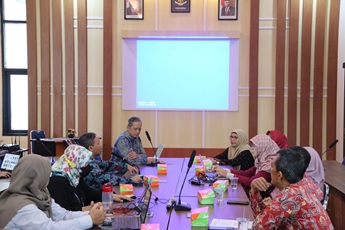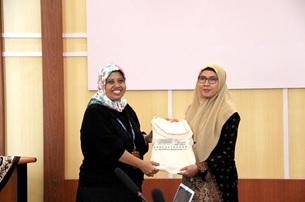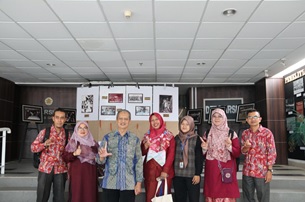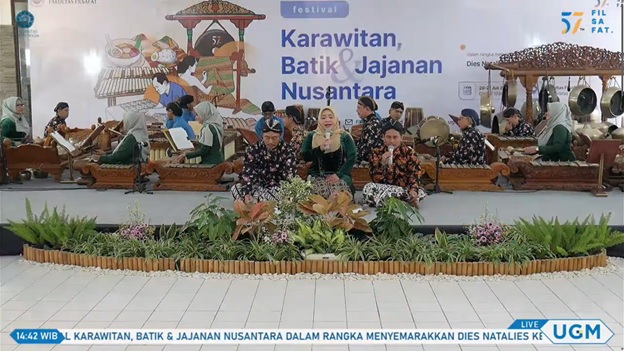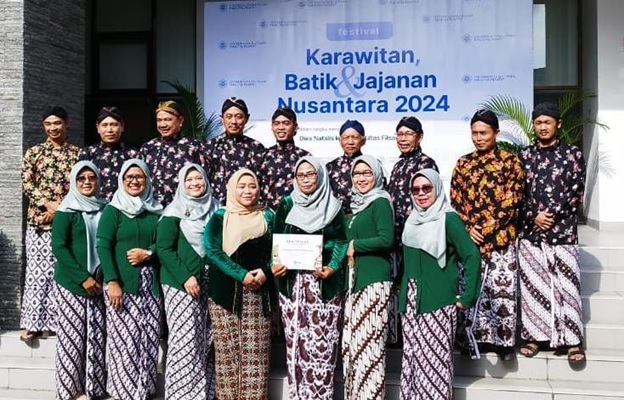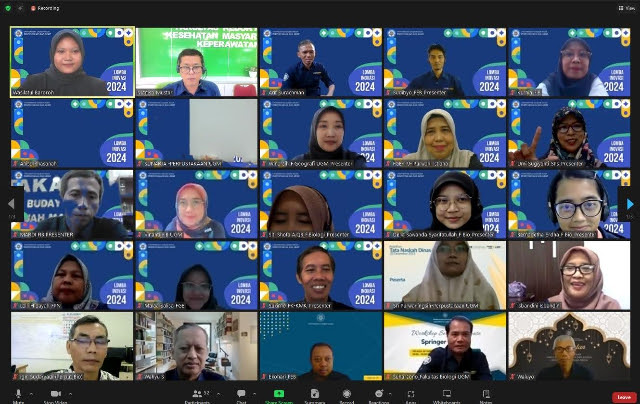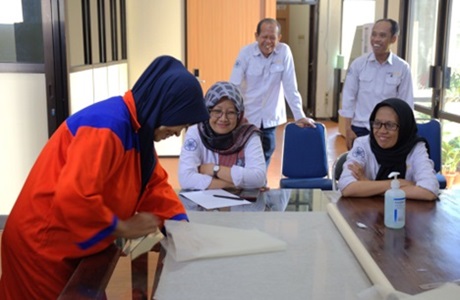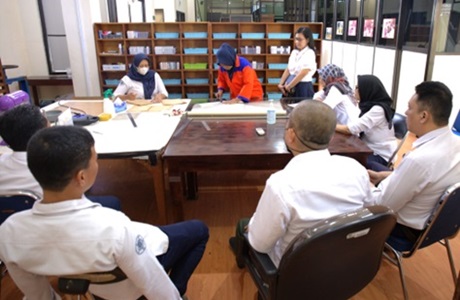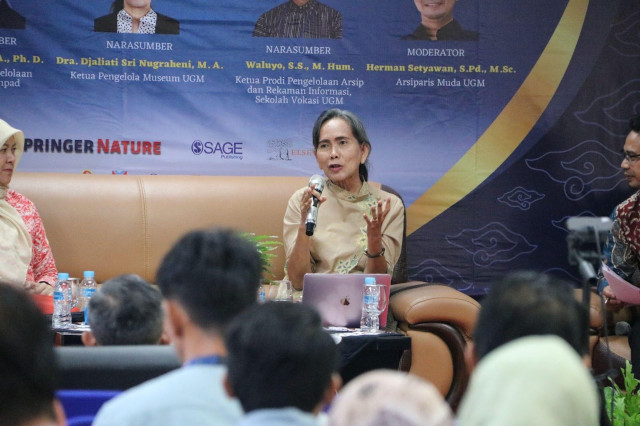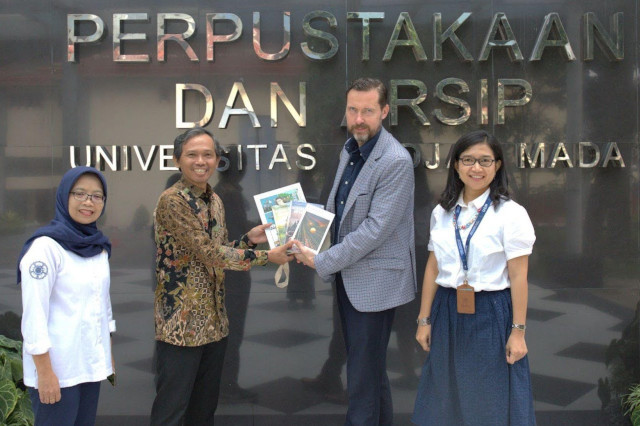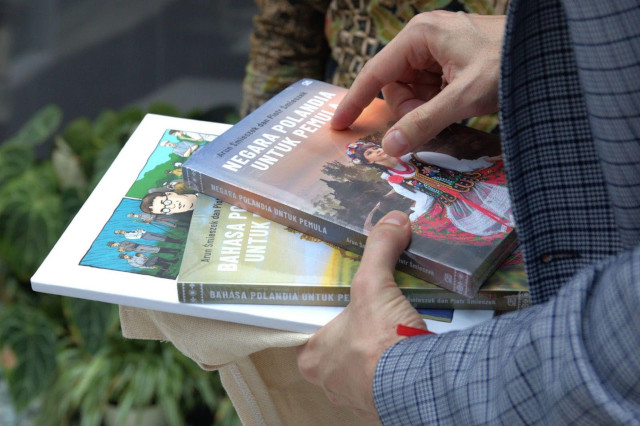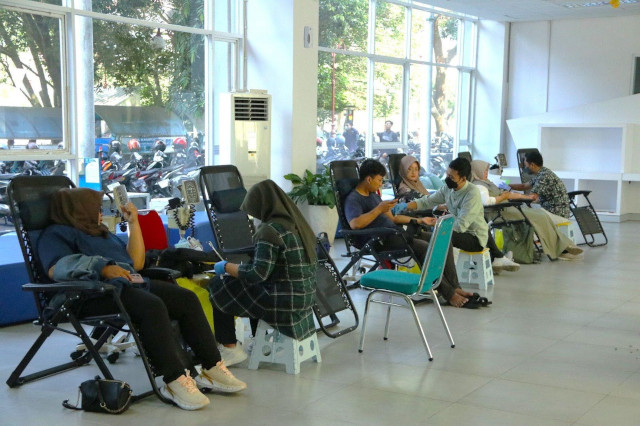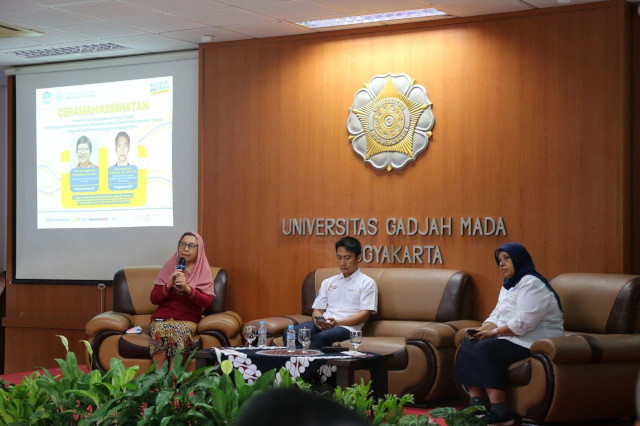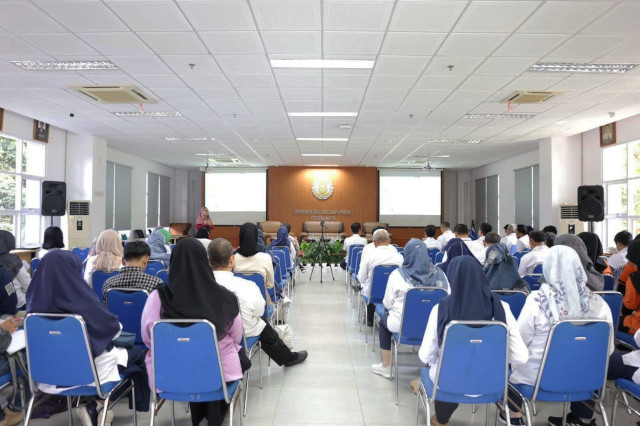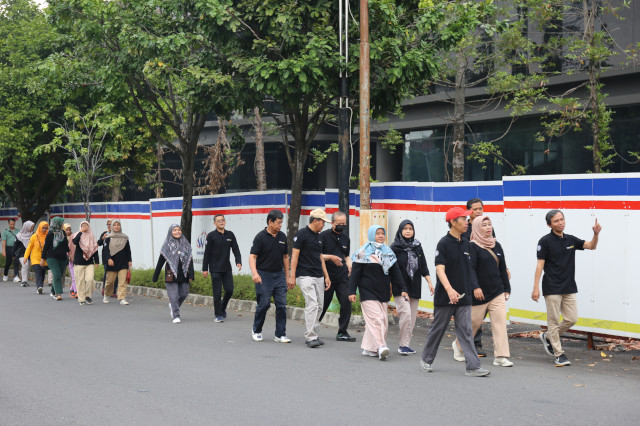- Home
- Post by
admin
Captivating Performance by Pustaka Laras at the 57th Dies Natalis Philosophy Festival
News Tuesday, 23 July 2024
In the vibrant celebration of the 57th Dies Natalis of the Faculty of Philosophy, the Library and Archives of Universitas Gadjah Mada (UGM) joined in the festivities of the Karawitan Festival. Held on Saturday and Sunday, July 20-21, 2024, the event showcased various karawitan groups from UGM’s different units as well as various communities from the Special Region of Yogyakarta (DIY).
One standout performance was by Pustaka Laras, the Karawitan Group from the Library and Archives of UGM. They performed the traditional song “Ladrang Ondhe-Ondhe Semarang dan Lelagon Jahe Wana” which received a warm reception from the audience. This performance not only provided entertainment but also carried deep significance in supporting the achievement of Sustainable Development Goal (SDG) 11: Sustainable Cities and Communities, which includes the preservation of cultural heritage and nature, realized here through the art of karawitan. In addition
to this, the Karawitan cultural performance is a manifestation of the implementation of ongoing cultural education, in line with SDG 4, which is Quality Education (cultural).
The Karawitan Festival served as a platform for the UGM academic community to demonstrate their commitment to preserving local culture through traditional music. By participating in this festival, Pustaka Laras reminds us of the rich cultural heritage of Indonesia that must be continuously preserved and cherished.
Through this event, the Library and Archives of UGM showcase their dedication to supporting Sustainable Development Goals and the preservation of cultural heritage. This spirit can inspire various parties to better appreciate and safeguard Indonesia’s cultural wealth for a brighter future.
Contributor: Wasilatul Baroroh
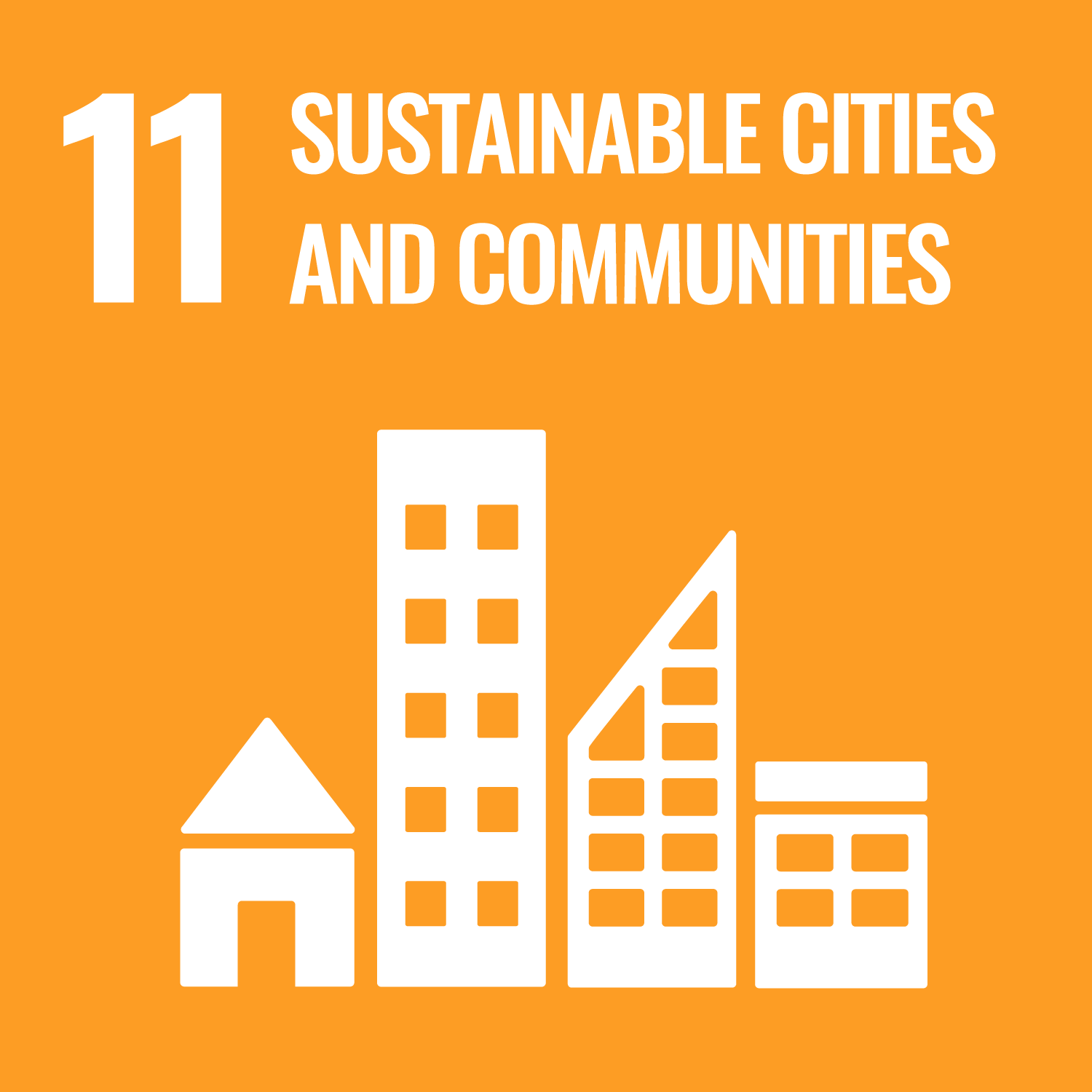
Innovation Competition to Encourage Creativity and Service Development
News Friday, 19 July 2024
Yogyakarta, 18 July 2024 - The Library and Archives of Universitas Gadjah Mada (UGM) proudly announce the winners of the Innovation Competition for Librarians and Archivists as part of the UGM Library and Archives Dies Natalis 2024. The competition, held from May 13 to July 5, 2024, featured innovative contests aimed at librarians, archivists, and library users within UGM to support the Merdeka Belajar – Kampus Merdeka (MBKM) program through innovations in providing student-centered learning facilities.
The innovations developed in this competition included the creation of videos showcasing the excellent services in the UGM Library and Archives, promoting the UGM Library and Archives services, and digital creative content. This competition provided challenges and opportunities for librarians, archivists, and library users within UGM to develop creativity and innovation in delivering excellent services.
The judging process was conducted by Arif Surachman, SIP, MBA, Head of the UGM Library and Archives, and Wisaksono Adi from InaHealth FKKMK UGM. Based on the judging results, here are the winners in each category:
Category: Outstanding Service Innovation in the UGM Library and Archives:
- 1st Place: Team FKKMK
- 2nd Place: Team FEB
- 3rd Place: Team Faculty of Geography
Category: Library and Archives Promotion:
- 1st Place: Adhika Pramudhia Kirana
- 2nd Place: Wulan Kusumaning Yuli & Dewi Amalia
- 3rd Place: Endah Choiriyah
Category: Digital Creative Content:
- 1st Place: Oktaviana Dwi Prastika
- 2nd Place: Nefertiti Aurelia Fadiahaya & Nur Kusumaning Ati
- 3rd Place: Manda Rahma Cyntia
The winning videos can be viewed on the Universitas Gadjah Mada Library YouTube channel. Through these videos, viewers can witness the extraordinary innovations carried out by the librarians, archivists, and library users within UGM. These videos showcase various outstanding services developed and provide insights into how these services can assist library users and the community in accessing information and reading materials.
The competition is expected to contribute to fostering reading interest and literacy in the community, thereby achieving quality education in line with the 4th SDG goal.
Contributor: Wasilatul Baroroh
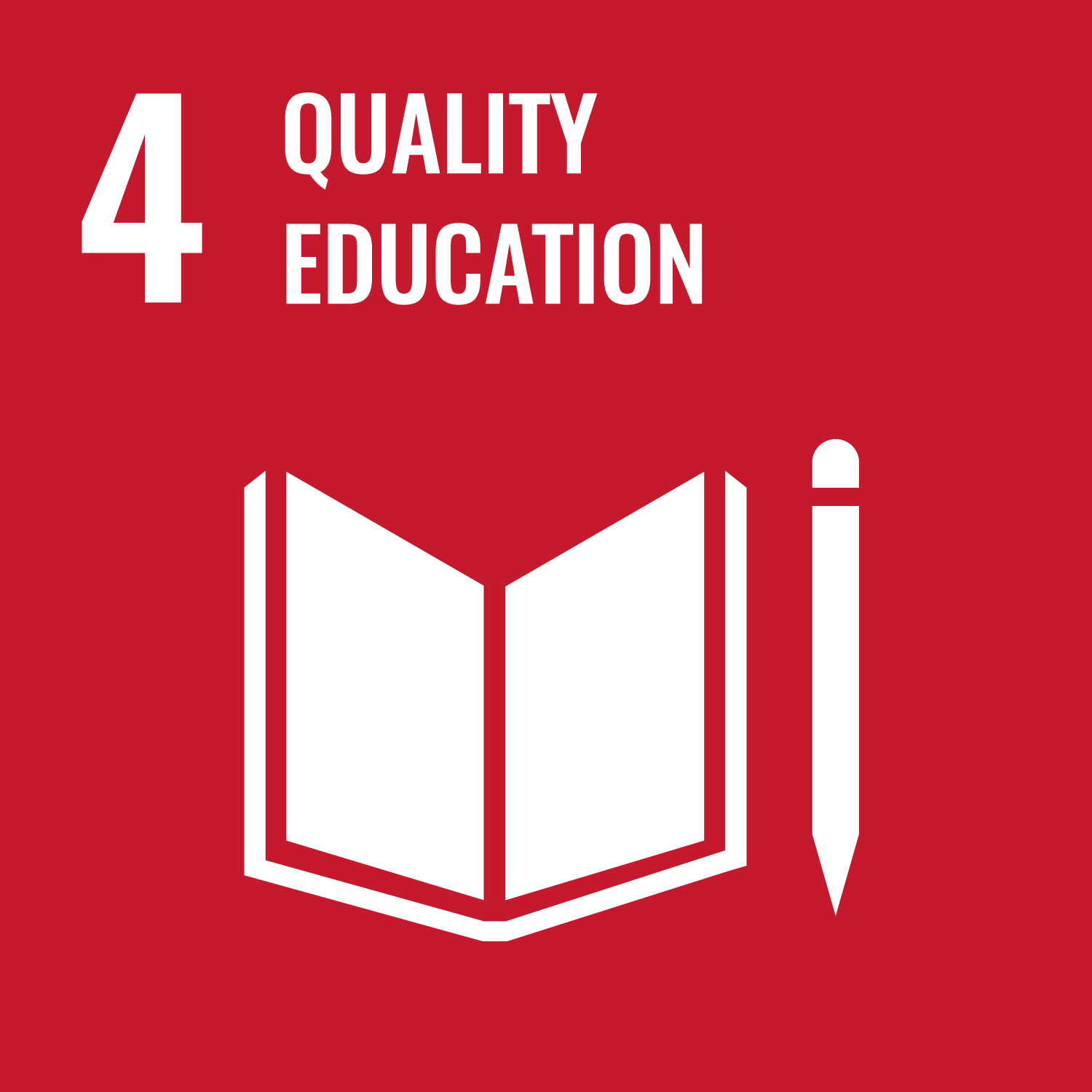
Behind the Scenes: UGM Library and Archives’ Efforts to Preserve Rare Collections
News Tuesday, 16 July 2024
The Universitas Gadjah Mada (UGM) Library and Archives hosted a rare collection preservation training on Monday, July 15, 2024, in the Archives Preservation Room. This training was led by the UGM Archives Preservation Team and attended by several librarians from the UGM Library and Archives.
This training aims to support the program for the preservation of the physical form of rare collections owned by the UGM Library and Archives, so that these collections can remain maintained and used for a longer period. This step is part of the UGM Library and Archives' efforts to achieve the fourth Sustainable Development Goal (SDG), which is quality education. In line with this goal, this activity also aligns with the 17th SDG, which is partnerships to achieve the goals. The UGM Library and Archives are committed to continuously strengthening inter-professional collaboration to achieve these objectives.
During the training, librarians were taught laminating techniques and methods, from making glue to the lamination process itself. Lamination is the process of covering paper with Japanese tissue to protect it from external factors that cause damage. It is hoped that with the knowledge and skills gained from this training, librarians will make significant contributions to preserving the cultural and intellectual heritage held by UGM Library and Archives.
The training is expected to be the first step in a series of preservation efforts for rare collections at UGM. With the capabilities and knowledge gained from this training, librarians are anticipated to contribute more to safeguarding the cultural and intellectual heritage of the UGM Library and Archives.
The UGM Library and Archives continues to strive to enhance the quality of its services and collections. This preservation training is a tangible demonstration of that commitment, as well as a strategic step in supporting quality education in Indonesia.
Contributor: Wasilatul Baroroh

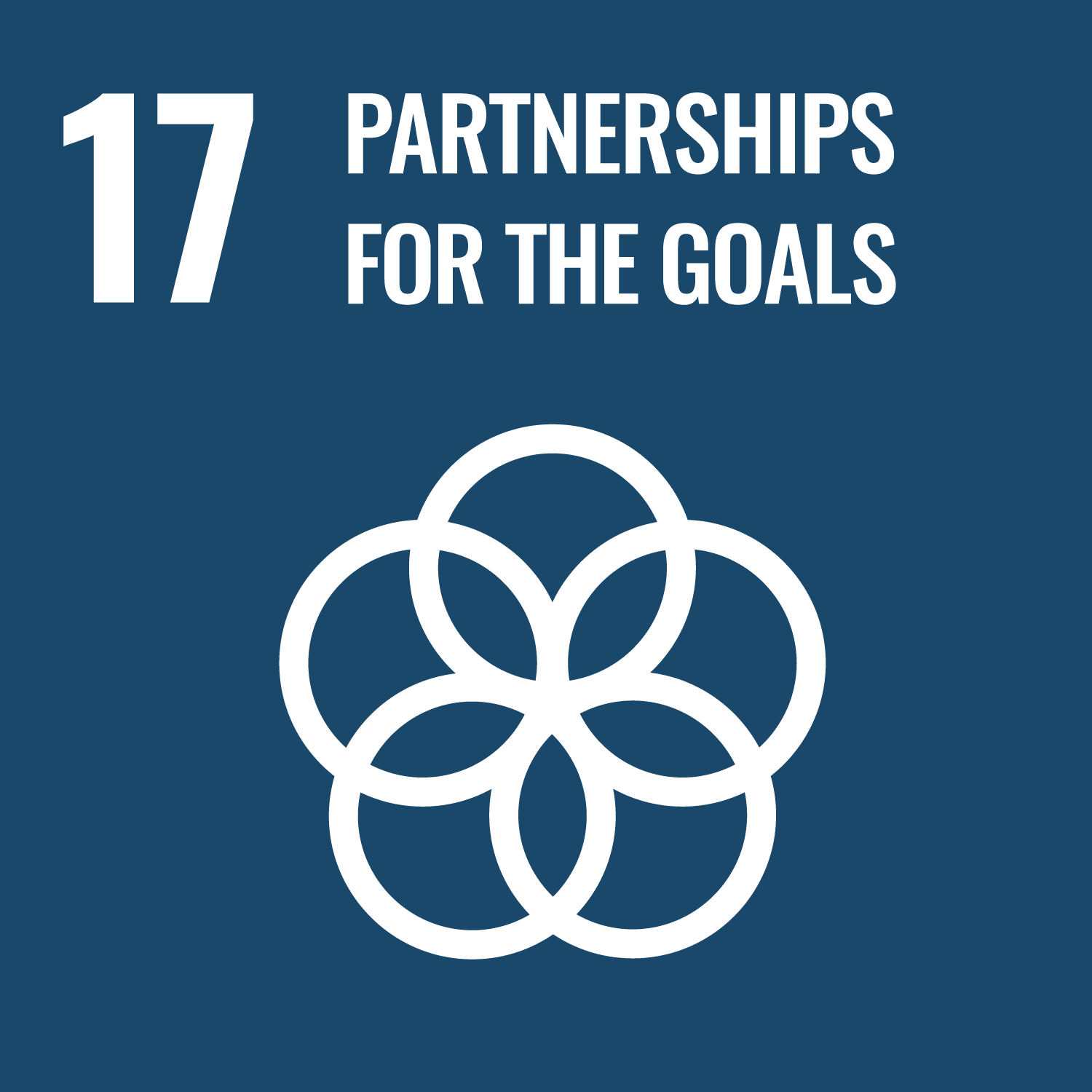
Cultural Heritage in Our Hands: UGM National Seminar Highlights Vital Role of Libraries, Archives, and Museums in Supporting SDGs
News Thursday, 11 July 2024
In commemoration of its first anniversary, Gadjah Mada University Library and Archives held a National Seminar titled "The Role of Libraries, Archives, and Museums in Preserving National Cultural Heritage and Supporting Sustainable Development Goals" on Thursday, July 11, 2024, at 09.00 AM WIB. Speakers included experts in library management, museum administration, and archiving. The seminar took place at the Seminar Room, L7 Building, 2nd Floor, Gadjah Mada University Library and Archives.
The seminar commenced with welcoming remarks from Arif Surachman, S.IP., M.B.A., Head of Library and Archives, and keynote speaker Prof. Dr. Wening Udasmoro, S.S., M.Hum., DEA, Vice Rector for Education and Academic Affairs. They emphasized the crucial role of libraries, archives, and museums in preserving cultural heritage and achieving SDGs.
The event featured three distinguished speakers who shared insights on the importance of cultural preservation aligned with SDGs. The first speaker, Wina Erwina, M.A., Ph.D., Head of Knowledge Management Center at Universitas Padjadjaran, presented on "The Role of Libraries in Cultural Preservation and Supporting SDGs." Dr. Erwina highlighted the pivotal role of libraries in safeguarding cultural heritage and promoting lifelong learning, essential for SDG 4: Quality Education. She discussed various initiatives by libraries to digitize and preserve cultural artifacts for broader accessibility, stressing the importance of collaborations with cultural institutions to enhance these efforts.
The second speaker, Dra. Djaliati Sri Nugrahani, M.A., Chairperson of UGM Museum Management, delivered a presentation on "The Role of Museums in Preserving National Cultural Heritage and Supporting SDGs." She explained how museums serve as guardians of cultural heritage, providing educational resources and fostering identity and continuity within communities. Dra. Nugrahani also discussed the role of museums in promoting sustainable tourism, aligning with SDG 8: Decent Work and Economic Growth, by attracting visitors and educating them about cultural heritage, thereby contributing to local economies and sustainable development.
The third speaker, Waluyo, S.S., M.Hum, Chair of the Archives and Information Records Management Program at UGM Vocational School, presented on "The Role of Higher Education Archives in Preserving National Cultural Heritage and Supporting SDGs". He underscored the importance of sound archiving practices in preserving historical records essential for research and education. Mr. Waluyo highlighted the need for higher education institutions to invest in modern archival technologies and training programs to ensure the sustainability and accessibility of cultural records. He also emphasized the role of archives in supporting SDG 16: Peace, Justice, and Strong Institutions by maintaining transparent and accountable records. In his presentation, he stressed the significance of cultural heritage preservation as a means to support sustainable cities and communities, central to SDG 11. He underscored that higher education archive institutions play a crucial role in documenting and safeguarding cultural artifacts, historical records, and other essential materials reflecting the cultural identity of the nation.
The seminar concluded with a lively panel discussion, where speakers addressed audience questions and shared additional insights into challenges and opportunities in cultural preservation. The event was attended by academics, students, and professionals from various cultural and educational institutions.
UGM Library and Archives hopes that this seminar will inspire further collaboration and innovation in cultural preservation, contributing to the achievement of SDGs. The event emphasized the importance of integrating cultural heritage preservation into broader development agendas, ensuring that future generations can enjoy and appreciate our rich cultural heritage.
Contributor: Farah Zayyinah Faiqotulhimmah



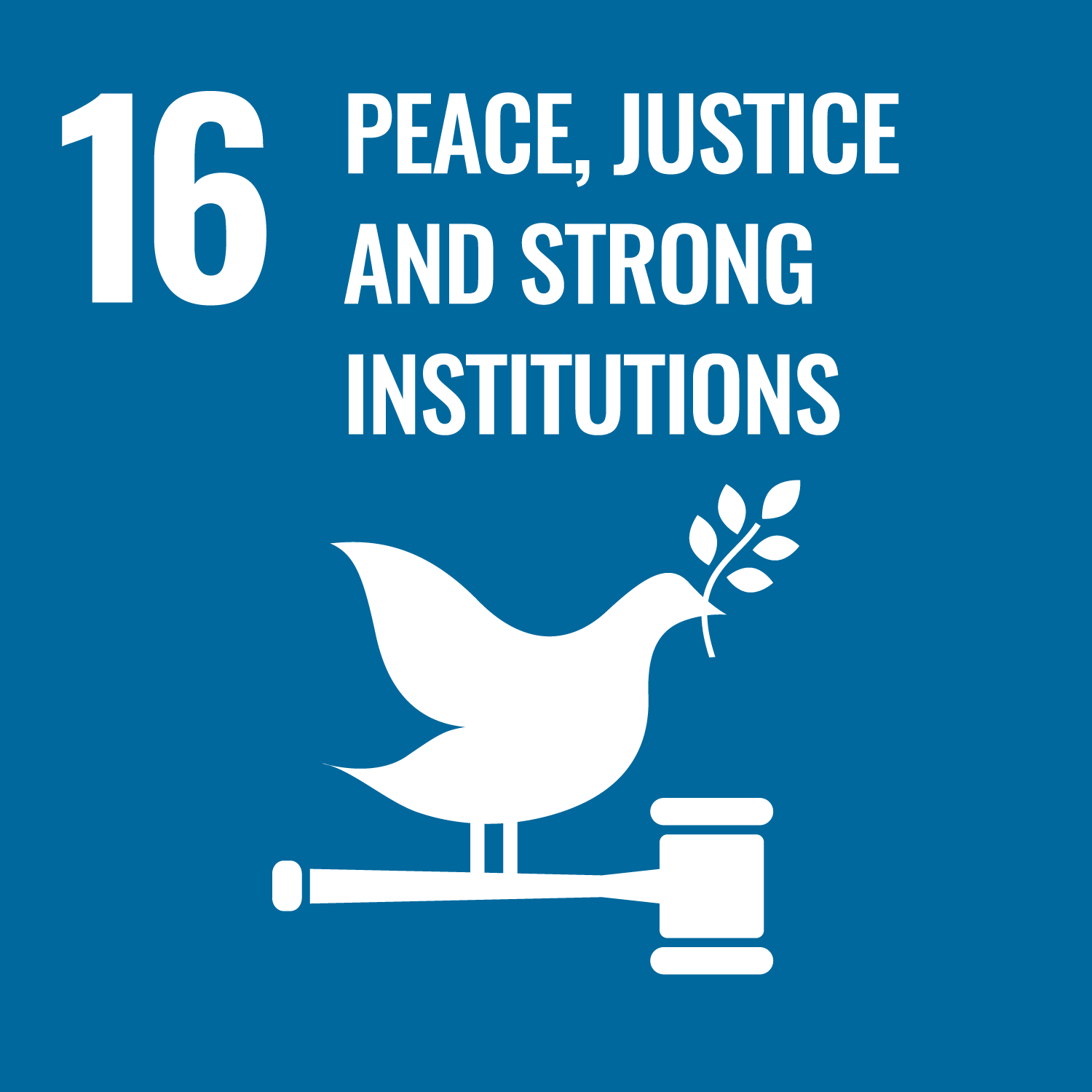
Polish Diplomat Brings Treasure Trove of Books to UGM Library and Archives: See What’s Given!
News Tuesday, 9 July 2024
The Polish Embassy for Indonesia gifts valuable books to UGM Library and Archives, enriching collections and bolstering global literacy.
Yogyakarta, July 8, 2024 - In a meeting brimming with literary spirit and international friendship, the Library and Archives of Gadjah Mada University (UGM) received an honorable visit from Piotr Firlus, Counsellor, Head of Political and Economic Section of the Polish Embassy for Indonesia. In a warmly welcoming atmosphere, Arif Surachman, S.IP., M.B.A., Head of UGM Library and Archives, along with Safirotu Khoir, Ph.D., Coordinator of Public Relations and International Affairs, and Erna Widayati, S.E., M.M. as the Head of the Archives Department, warmly welcomed the Polish diplomat. This wasn’t just an ordinary visit, Piotr Firlus came to present a valuable donation of books that will enrich UGM Library’s collection and provide new insights into Poland for readers.
The donated books include:
- Polish Language for Beginners: A practical guide for those eager to learn Polish from scratch.
- Poland for Beginners: An introductory book detailing the history, culture, and modern life in Poland.
- Jozef Zwierzycki: Expert Geologist of the Indonesian Archipelago and Poland: A work depicting the contributions of a Polish geologist to the study of the Indonesian archipelago.
- Solaris: A science fiction masterpiece by Stanisław Lem that offers profound reflections on humanity and the universe.
The books were written by Polish authors in Indonesian, making them invaluable resources for the library and archives patrons at UGM to better understand the culture and knowledge of Poland directly in their own language. Piotr Firlus expressed his great hope that this book donation could serve as a bridge of knowledge, encouraging many UGM students to continue their studies in Poland, thereby fostering a closer and mutually beneficial academic exchange between the two countries.
Arif Surachman expressed deep appreciation, stating, "This donation not only enriches our library’s collection but also opens new horizons for readers. It’s a concrete step towards strengthening bilateral relations and expanding global knowledge."
This visit exemplifies Sustainable Development Goal (SDG) 17: Partnerships for the Goals. International cooperation like this is key to achieving progress and common goals. With this book donation, UGM Library and Archives reaffirm their commitment to becoming an inclusive knowledge hub that supports cultural and academic exchanges globally. May the relationship with the Polish Embassy continue to thrive and benefit both sides.
Contributor: Wasilatul Baroroh

MCU RSA UGM Goes to Campus: Stepping Towards a Healthier Future
News Wednesday, 3 July 2024
The MCU RSA Goes to Campus event was held at the UGM Library and Archives in collaboration with Gadjah Mada Medical Center (GMC) and UGM Academic Hospital (RSA UGM).
Yogyakarta, July 1, 2024 – The spirit of life gathered at Gadjah Mada University’s Library and Archives with the presence of MCU RSA UGM Goes to Campus. This event is part of the first anniversary celebrations of UGM Library and Archives. MCU RSA UGM Goes to Campus not only raises awareness of the importance of health but also demonstrates UGM’s commitment to supporting the achievement of Sustainable Development Goals (SDGs) 3: Health and Well-being.
The event took place in the Windows of the World (WOW) Room and the Disabilities Room at UGM Library and Archives. In collaboration with Gadjah Mada Medical Center (GMC) and UGM Academic Hospital (RSA UGM), the event attracted the participation of 30 individuals from across the UGM Library and Archives staff. Among them, 20 participants were individuals above the age of 50
who underwent a series of health examinations, while the remaining 10 participants were under the age of 50. The health screenings included anthropometry, BMI (Body Mass Index), blood tests, urine tests, and Electrocardiography (EKG).
“We are grateful and proud of the enthusiasm shown by the participants in MCU RSA Goes to Campus. Besides being a celebration of the first anniversary of UGM Library and Archives, this event also serves as a crucial moment to support the achievement of Sustainable Development Goals," expressed Sarwono, SIP., MA., Chairman of the 1st Anniversary Committee of UGM Library and Archives. "We believe that every small step taken towards maintaining health has a significant impact on building a healthier society.”
UGM Library and Archives is committed to maintaining the health of its staff as an investment in a better future. The support from GMC and RSA UGM in organizing this MCU reflects a strong collaboration between education and healthcare services. This event is not only about physical health check-ups but also about educating and empowering individuals to live healthier lives. Health is a gift that must be maintained wisely. With strong collaboration, a solid foundation will be built for a healthier future.
Contributor: Wasilatul Baroroh
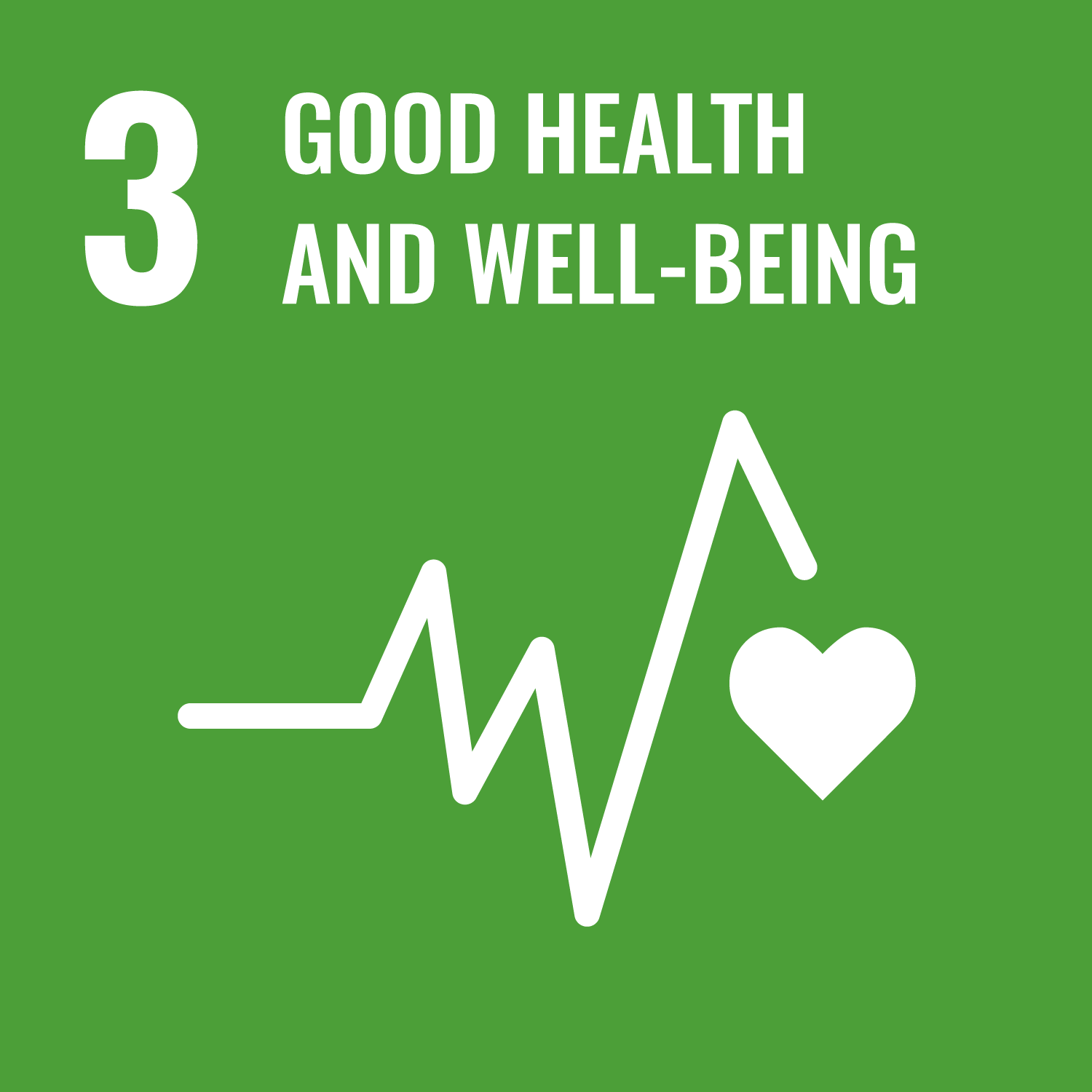
“Our Blood, Our Story”: Blood Donation Action at UGM Library and Archives Strengthens Commitment to Health and Well-being
News Wednesday, 3 July 2024
UGM Library and Archives, in collaboration with UGM Academic Hospital, organized a blood donation drive.
Gadjah Mada University's Library and Archives transformed the Windows of the World (WOW) Room into a place unlike any other. It served not only as a space for learning but also as a silent witness to a meaningful celebration. On Monday, July 1, 2024, UGM Library and Archives hosted a blood donation drive in the WOW Room, a small step with significant impact on life and well-being. This event was part of the first anniversary celebrations of UGM Library and Archives and a concrete effort to support Sustainable Development Goals (SDGs) 3: Good Health and Well-being.
The blood donation drive was held in collaboration with UGM Academic Hospital and was attended by 64 participants, including faculty, educational staff, and UGM students. Participants enthusiastically donated their blood as an expression of care for others and to support efforts in ensuring an adequate blood supply in hospitals. They came with sincere intentions to give life to those in need, weaving humanity with every drop of blood donated.
“For me, blood donation is very beneficial, especially for health, where our blood will be replaced with new blood. Especially if our blood donation can be immediately utilized for those in need, it feels very sincere,” expressed Aryanto Adi Nugroho, one of the blood donors. “Blood donation during the 1st Anniversary of UGM Library and Archives was very enjoyable, the service was excellent, and there was no long waiting time, it only took about 10 minutes to finish. Congratulations on the 1st Anniversary of UGM Library and Archives. Regards to Literacy.”
The blood donation process proceeded smoothly while adhering to health protocols, creating a safe environment for donors. Each participant received appreciation for their contribution to collective efforts in achieving a healthier society. This event served not only as a blood donation campaign but also as a tangible manifestation of the institution's commitment to actively engage in health and well-being development for the community.
This activity was not just part of a celebration but also a reminder of the importance of health and well-being for all. With a spirit of togetherness, UGM Library and Archives remains committed to continuing its contributions towards creating a better world through various positive initiatives. Amidst the bustling campus life, this event was a breath of fresh air, reminding us of the importance of solidarity and empathy.
As this event concludes successfully, organizers extend their gratitude to all participants and stakeholders for their support in promoting SDG 3 through tangible actions like blood donation. Let's weave a healthier and more prosperous future together, in unity and compassion.
Contributor: Wasilatul Baroroh

The Importance of Mental Health and Nutrition: Library and Archives Host Health Lecture
News Wednesday, 3 July 2024
Mental Health and Nutrition have become concerns for many parties considering their significant impact on the productivity of working staff. This includes the staff of the Library and Archives. In celebration of its first anniversary, the Library and Archives organized a health lecture on Monday (1/7) at the Seminar Room of the Library and Archives, conducted in a hybrid format and attended by participants from all librarians, archivists, library staff, and archive staff within Universitas Gadjah Mada, as well as open to limited Library visitors. The Health Lecture is one of the collaborative activities between RSA UGM, HPU UGM, and GMC, along with a series of blood donation activities and RSA Goes to Campus, all held simultaneously.
"This Health Lecture is held precisely on July 1 as part of the first anniversary celebration of the Library and Archives of UGM," said Sarwono, S.IP., M.A., chairman of the Library and Archives anniversary committee for 2024. "According to survey results, awareness of mental health remains low," added Arif Surachman, S.IP., M.B.A., Head of the Library and Archives, in his remarks.
It is hoped that this event will help improve staff's ability to manage their mental health accompanied by balanced nutrition. This activity also reflects the commitment of the Library and Archives to implement SDG Goal 3 on Good Health and Well-being.
Healthy mental state is certainly inseparable from physical well-being. "With a healthy body, mental health will also follow suit, and we should be the ones managing our schedules, not the other way around," said Prof. Dra. Yayi Suryo Prabandari, M.Si., Ph.D., delivering the Mental Health content.
"Change must start from small things, even being grateful for the smallest things can make us happier, just as physical activities can increase endorphin hormones, which have positive effects on mental health," she added.
Mental health also depends on the quality of the food we consume. "The better the nutritional content of the food we consume, the better it is for our bodies," as stated by Tony Arjuna, S.Gz., M.Nut.Diet., AN., APD., Ph.D., during his presentation on Nutrition Management. "There are millions of microbes entering our mouths from food, so we must be more selective about what goes into our mouths," he explained.
"The effects of the food we eat also manifest gradually over the long term. Besides the type of food, improper eating patterns can also impact health, including feelings of fatigue, drowsiness, mood swings, brain fog, and depression," he stated.
Both speakers managed to lighten the atmosphere, and participants appeared enthusiastic in listening and asking questions, both online and offline. Following the presentations and Q&A session, three top questioners received door prizes from the Library and Archives.
Contributor: Nabiilah

Healthy Steps on Campus: UGM Library and Archives Hold Exciting Fun Walk!
News Monday, 1 July 2024
Universitas Gadjah Mada Library and Archives held a healthy walk in celebration of its first anniversary. The event took place around the UGM campus area. The route was from UGM Library and Archives to the south through GSP towards the alumni office then to DPKM and back north to UGM Library and Archives. This activity was attended by employees and education personnel. The event, which started at 07.00 am, aims to promote a lifestyle that is in line with the Sustainable Development Goals (SDGs) point 3 of ensuring a healthy life and improving the welfare of all people of all ages.
Head of Library Arif Suratman, SIP, M.B.A, before releasing the participants of the healthy walk, stated that this event is one part of the implementation of Health Promoting Unit activities in collaboration with the integrated health bureau supported by RSA UGM and Gadjah Mada Medical Center. The organization of this way implements the SDGs, especially in terms of health and welfare (SDG3) and quality education (SDG 4).
The library can then become a community health for the Gadjah Mada University community that always supports according to UGM's vision and mission. So in the future we are very supportive if there are programs from HPU / RSA / GMC to support each vision and mission further and routinely.
UGM Library and Archives took this opportunity to introduce their various initiatives and programs that support SDGs. As one of the leading universities in Indonesia, UGM continues to strive to be a pioneer in the implementation of activities that are oriented towards sustainability and community welfare. With this healthy walk event, UGM Library and Archives hopes to inspire more people to live a healthy lifestyle in accordance with the implementation of SDGs point 3.
Contributor: Srani Riska Viantami


